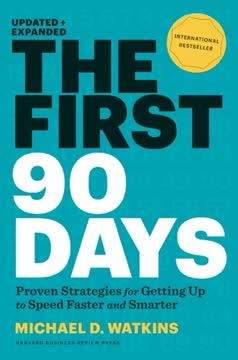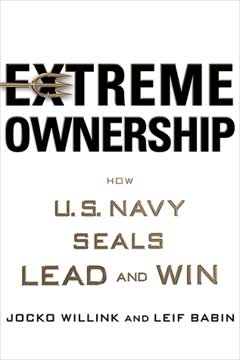Key Takeaways
1. Stress significantly impairs leadership decision-making
Smart leaders with proven track records sometimes suddenly begin making really bad decisions—or no decisions at all.
Stress degrades decision quality. As stress levels increase, leaders lose access to their full cognitive and emotional capabilities. This can lead to poor choices, analysis paralysis, or emotional reactions rather than thoughtful decisions. Even experienced, intelligent leaders can make catastrophic errors when under extreme pressure. Notable examples include the leaders of companies like Enron, WorldCom, and Bear Stearns who made a series of disastrous decisions during times of organizational crisis.
Stress affects all aspects of decision-making:
- Perception becomes narrowed and biased
- Information processing slows down
- Working memory capacity decreases
- Ability to consider long-term consequences diminishes
- Tendency to revert to automatic/habitual responses increases
2. Cognitive and emotional intelligence are crucial for effective leadership
Good leaders make good decisions under stress.
Two key leadership qualities. Cognitive intelligence (IQ) provides the analytical and problem-solving abilities needed to understand complex situations and generate solutions. Emotional intelligence (EQ) enables leaders to manage their own emotions, empathize with others, and navigate interpersonal dynamics. Both are essential for sound decision-making, especially under pressure.
Balancing IQ and EQ:
- High IQ alone is insufficient - many intelligent leaders still fail
- EQ becomes increasingly important at higher leadership levels
Effective leaders leverage both to:- Analyze situations rationally
- Manage their own stress response
- Understand and influence others
- Make balanced decisions considering both logic and human factors
3. The brain's response to stress affects decision quality
When stress is sufficiently elevated, a leader's ability to fully and effectively use cognitive intelligence and emotional intelligence to make timely and effective decisions may be significantly impaired.
The stress effect. When the brain perceives stress, it triggers a "chemical bath" of hormones like cortisol and adrenaline. This physiological response evolved to help humans survive immediate physical threats. However, it can be maladaptive in modern leadership contexts:
- The prefrontal cortex (responsible for executive functions) is impaired
- The amygdala (emotion and threat detection center) becomes hyperactive
- Decision-making shifts from deliberate to automatic/intuitive modes
- Perception narrows, filtering out potentially important information
- Time horizons shorten, favoring short-term over long-term thinking
Neuroscience insights: Understanding these brain mechanisms allows leaders to recognize when stress is affecting their judgment and take steps to mitigate its impact.
4. Leaders must develop stress management capacity
Stress management capacity refers to the total ability the leader has to manage stress.
Building resilience. Leaders can increase their ability to function effectively under pressure by expanding their "comfort zone" - the range of stress levels they can handle without significant performance degradation. This involves:
- Gradual exposure to increasingly challenging situations
- Developing coping strategies and stress reduction techniques
- Improving physical health and stamina
- Cultivating a growth mindset towards stressful experiences
Practical approaches:
- Regular practice of relaxation techniques (e.g. meditation, deep breathing)
- Physical exercise and proper nutrition
- Adequate sleep and recovery time
- Building strong support networks
- Continuous learning and skill development
5. Cognitive resilience helps maintain mental performance under pressure
Cognitive resilience is about protecting cognitive intelligence from stress.
Preserving mental function. Cognitive resilience allows leaders to maintain access to their full intellectual capabilities even when stressed. This involves:
- Awareness of cognitive processes and how stress affects them
- Techniques to manage cognitive load and preserve working memory
- Strategies to maintain focus and avoid distractions
- Methods to combat decision fatigue
Key practices:
- Mindfulness training to improve meta-cognition
- Using external memory aids and checklists
- Breaking complex problems into manageable chunks
- Periodic "brain breaks" to recharge mental energy
- Developing automatic/intuitive decision-making for routine situations
6. Emotional intelligence becomes more critical as stress increases
As the stress level increases, emotional intelligence decreases.
Managing emotions under pressure. High stress tends to amplify emotional reactions and reduce rational control. Leaders with strong emotional intelligence are better equipped to:
- Recognize and regulate their own emotional states
- Avoid emotional contagion in high-pressure team situations
- Maintain empathy and interpersonal effectiveness
- Make decisions balancing emotional and logical inputs
Developing emotional resilience:
- Regular self-reflection and emotional self-awareness practices
- Learning to identify and reframe negative thought patterns
- Cultivating positive emotions like gratitude and optimism
- Practicing empathy and perspective-taking
- Building strong relationships and support networks
7. The ARSENAL system builds stress resilience in leaders
ARSENAL: The Seven Best Practices
Holistic approach. The ARSENAL system provides a comprehensive framework for developing leadership resilience:
A - Awareness
R - Rest
S - Support
E - Exercise
N - Nutrition
A - Attitude
L - Learning
By systematically improving in each of these areas, leaders can dramatically increase their capacity to perform under pressure and make sound decisions in stressful situations.
8. Awareness is foundational to stress management
Awareness is the foundation for developing all ARSENAL best practices.
Cultivating self-knowledge. Leaders must develop keen awareness of:
- Their own stress levels and triggers
- How stress affects their cognition, emotions, and behavior
- Early warning signs of stress overload
- The effectiveness of their coping strategies
Practical awareness techniques:
- Regular self-assessment using stress scales or "dashboards"
- Mindfulness meditation to improve present-moment awareness
- Journaling to track patterns and insights
- Seeking feedback from trusted colleagues and mentors
- Using biofeedback or other physiological monitoring tools
9. Rest and recovery are essential for sustained leadership performance
All high performing systems require downtime.
The power of rest. Adequate rest and recovery allow the brain and body to repair, consolidate learning, and prepare for future challenges. Leaders must prioritize:
- Sufficient high-quality sleep (7-9 hours for most adults)
- Regular breaks throughout the workday
- Vacations and extended periods of downtime
- Activities that promote mental and physical relaxation
Rest strategies:
- Establishing consistent sleep routines
- Creating a restful sleep environment
- Using relaxation techniques like progressive muscle relaxation
- Taking brief "power naps" (15-20 minutes) when needed
- Engaging in restorative hobbies and leisure activities
10. Support systems buffer against leadership stress
Support refers to the psychological, emotional, and physical help you get from others.
Building a network. Strong support systems provide:
- Emotional validation and stress relief
- Different perspectives on challenges
- Practical assistance and resources
- A sense of belonging and purpose
Developing support:
- Cultivating close personal relationships
- Building a diverse professional network
- Participating in peer support groups or mastermind circles
- Engaging with mentors and coaches
- Contributing to and drawing strength from community involvement
Last updated:
FAQ
1. What is The Stress Effect by Henry L. Thompson about?
- Leadership under stress: The book explores why even highly intelligent leaders make poor decisions when under stress, focusing on the interplay between cognitive and emotional intelligence.
- Scientific and practical approach: Thompson uses neuroscience, real-world examples, and leadership studies to explain how stress impairs decision making.
- Actionable strategies: The book provides practical advice and models to help leaders recognize, manage, and mitigate the negative effects of stress on their performance.
2. Why should I read The Stress Effect by Henry L. Thompson?
- Understand leadership failures: The book reveals the hidden ways stress can undermine even the smartest leaders, leading to catastrophic mistakes in business, military, and personal contexts.
- Improve decision making: Readers gain tools to recognize stress responses and implement strategies to maintain clarity and control under pressure.
- Build resilience: Thompson offers a systematic approach to developing stress resilience, helping leaders sustain high performance and avoid burnout.
3. What are the key takeaways from The Stress Effect by Henry L. Thompson?
- Stress impairs intelligence: Both cognitive and emotional intelligences are compromised under stress, leading to poor decisions.
- Resilience is trainable: Leaders can build stress management capacity, cognitive resilience, and stress-resilient emotional intelligence through targeted practices.
- Practical models and tools: The book introduces frameworks like the PAMA model and ARSENAL best practices to help leaders manage stress and make better decisions.
4. What are the two essential qualities for leadership according to The Stress Effect by Henry L. Thompson?
- Cognitive intelligence: The ability to process, organize, and retrieve information, crucial for solving complex problems and making effective decisions.
- Emotional intelligence: The capacity to perceive, understand, and manage one’s own emotions and those of others, essential for interpersonal effectiveness.
- Stress management: The book emphasizes that both intelligences are impaired by stress, making stress resilience a vital leadership quality.
5. How does The Stress Effect by Henry L. Thompson explain decision making in leadership?
- Rational and intuitive strategies: Leaders use both logical, analytical approaches and fast, automatic, emotional responses depending on the situation.
- Decision-making models: The book discusses frameworks like the Perception-Appraisal-Motivation-Action (PAMA) model, Boyd’s OODA loop, and Klein’s Recognition-Primed Decision (RPD) model.
- Matching strategy to context: Effective leaders know when to use each strategy and how stress can shift their decision-making approach.
6. What is the Perception-Appraisal-Motivation-Action (PAMA) model in The Stress Effect by Henry L. Thompson?
- Comprehensive decision framework: PAMA describes decision making as a cycle: perceiving a stimulus, appraising it cognitively and emotionally, becoming motivated, and taking action.
- Dynamic and recursive: The model emphasizes continuous updating of perceptions and appraisals, especially as situations evolve under stress.
- Integration of cognition and emotion: PAMA illustrates how cognitive and emotional intelligence interact, and how stress can disrupt this balance.
7. How does stress affect cognitive intelligence and decision making in The Stress Effect by Henry L. Thompson?
- Chemical and physiological impact: Stress releases hormones like cortisol, which initially boost but eventually impair brain functions critical for decision making.
- Reduced cognitive capacity: High stress diminishes the prefrontal cortex’s ability to process information, leading to impaired memory, narrowed focus, and shorter time horizons.
- Emotional dominance: As cognitive resources decline, emotional centers like the amygdala take over, increasing impulsivity and reducing decision quality.
8. What role does emotional intelligence play in decision making under stress in The Stress Effect by Henry L. Thompson?
- Emotions drive motivation: Emotions are goal-oriented impulses that influence motivation and action, making emotional intelligence crucial for effective leadership.
- Amygdala hijacking: Under extreme stress, the amygdala can override rational thought, causing leaders to make poor, emotionally driven decisions.
- Balancing cognition and emotion: Leaders with high emotional intelligence can manage their responses, preventing stress from degrading decision quality and relationships.
9. What is the Stress Resilient System in The Stress Effect by Henry L. Thompson and how does it work?
- Three-part system: The Stress Resilient System consists of Stress Management Capacity (SMC), Cognitive Resilience (CR), and Stress Resilient Emotional Intelligence (SREI).
- Protects against failure: This triad helps leaders maintain effective decision making under stress and avoid catastrophic leadership failures.
- Synergistic development: Each component supports the others, and together they form a holistic approach to stress resilience.
10. What are the ARSENAL best practices in The Stress Effect by Henry L. Thompson and how do they help manage stress?
- Seven key practices: ARSENAL stands for Awareness, Rest, Support, Exercise, Nutrition, Attitude, and Learning.
- Holistic resilience building: These practices interact to enhance cognitive and emotional functioning, increasing overall stress resilience.
- Practical implementation: The book provides self-assessment tools and actionable techniques for each practice, helping leaders identify and strengthen weak areas.
11. How can leaders build resilience to stress and improve decision making according to The Stress Effect by Henry L. Thompson?
- Develop stress management capacity: Techniques like high-stress training, rest, and recovery help leaders handle greater stress without performance loss.
- Enhance cognitive resilience: Practices such as adequate sleep, overlearning, and preplanning maintain cognitive abilities under pressure.
- Strengthen emotional intelligence: Building awareness and control of emotions helps leaders avoid emotional hijacking and maintain effective relationships during crises.
12. What real-world examples does The Stress Effect by Henry L. Thompson use to illustrate stress and decision making?
- Military and crisis leadership: The book draws on the author’s experiences in Vietnam and special operations training to show how stress management capacity is built.
- US Airways Flight 1549: Captain Sullenberger’s emergency landing demonstrates effective decision making under extreme stress, highlighting the importance of training and emotional control.
- Corporate and law enforcement cases: Examples like the 2008 financial crisis and police training labs illustrate how stress impairs decision making and the need for stress-resilient emotional intelligence.
Review Summary
The reviews for The Stress Effect are generally positive, with an average rating of 4.06 out of 5. Readers appreciate the book's insights on stress management, decision-making, and leadership. Many found the author's examples and personal experiences valuable. Some reviewers praised the comprehensive approach and fresh perspective on stress in leadership. A few readers felt parts of the book were dry or uninteresting, while others highlighted its usefulness for executives, coaches, and those in high-stress positions. Overall, most readers found it informative and applicable to both personal and professional life.
Similar Books










Download PDF
Download EPUB
.epub digital book format is ideal for reading ebooks on phones, tablets, and e-readers.




